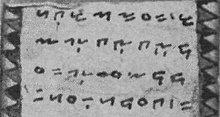
Malay was first used in the first millennia known as Old Malay, a part of the Austronesian language family. Over a period of two millennia, Malay has undergone various stages of development that derived from different layers of foreign influences through international trade, religious expansion, colonisation and developments of new socio-political trends. The oldest form of Malay is descended from the Proto-Malayo-Polynesian language spoken by the earliest Austronesian settlers in Southeast Asia. This form would later evolve into Old Malay when Indian cultures and religions began penetrating the region, most probably using the Kawi and Rencong scripts, some linguistic researchers say. Old Malay contained some terms that exist today, but are unintelligible to modern speakers, while the modern language is already largely recognisable in written Classical Malay of 1303 CE.[2]
Malay evolved extensively into Classical Malay through the gradual influx of numerous elements of Arabic and Persian vocabulary when Islam made its way to the region. Initially, Classical Malay was a diverse group of dialects, reflecting the varied origins of the Malay kingdoms of Southeast Asia. One of these dialects that was developed in the literary tradition of Malacca in the 15th century, eventually became predominant. The strong influence of Malacca in international trade in the region resulted in Malay as a lingua franca in commerce and diplomacy, a status that it maintained throughout the age of the succeeding Malay sultanates, the European colonial era and the modern times. From the 19th to 20th century, Malay evolved progressively through significant grammatical improvements and lexical enrichment into a modern language with more than 800,000 phrases in various disciplines.
- ^ Voorhoeve, P. (1970). "Kerintji Documents". Bijdragen tot de Taal-, Land- en Volkenkunde. 126 (4): 369–399. doi:10.1163/22134379-90002797.
- ^ Teeuw 1959, p. 149
